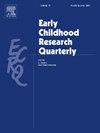Exploring the relation between early childhood education and historical and contemporary racism and bias for Black children
IF 3.2
1区 教育学
Q1 EDUCATION & EDUCATIONAL RESEARCH
引用次数: 0
Abstract
Racial disparities in educational outcomes start early in childhood and persist through adulthood. High quality Early Care and Education (ECE) programs tend to show benefits for Black children, but less is known about how larger contextual inequalities, both historical and contemporary, relate to young children's outcomes in these high-quality settings. Previous work has shown that historical racism, such as the prevalence of enslavement in 1860 (just before the Civil War) relates to present-day structural inequalities and implicit bias across geographic regions. In this study (N = 1,343), we examined the relation between an area's historical racism, operationalized as the proportion of enslaved individuals living there in 1860, current structural inequalities (economic mobility, racial disparities in poverty, and residential segregation), implicit bias, and children's outcomes in high quality ECE settings. Although significant correlations were found among historical and current structural inequities, implicit bias, and children's outcomes, no significant relation remained after accounting for nesting and children's prior skills. Though more work is needed to establish the reliability and robustness of these findings, our analysis provides initial evidence that negative structural factors are not linked to children's outcomes within more optimal settings, such as high quality ECE programs.
探讨幼儿教育与历史和当代种族主义和对黑人儿童的偏见之间的关系
教育成果方面的种族差异始于童年早期,并持续到成年。高质量的早期护理和教育(ECE)项目往往对黑人儿童有利,但人们对历史和当代背景下更大的不平等与儿童在这些高质量环境中的表现之间的关系知之甚少。先前的研究表明,历史上的种族主义,比如1860年(就在内战之前)奴隶制的盛行,与当今的结构性不平等和跨地理区域的隐性偏见有关。在这项研究中(N = 1343),我们考察了一个地区历史上的种族主义(以1860年居住在该地区的被奴役者的比例计算)、当前的结构性不平等(经济流动性、贫困中的种族差异和居住隔离)、隐性偏见与高质量ECE环境中儿童的结果之间的关系。尽管在历史和当前的结构不平等、内隐偏见和孩子的结果之间发现了显著的相关性,但在考虑筑巢和孩子的先前技能之后,没有显著的相关性。虽然需要更多的工作来建立这些发现的可靠性和稳健性,但我们的分析提供了初步证据,表明在更理想的环境下,如高质量的ECE项目,负面结构因素与儿童的结果无关。
本文章由计算机程序翻译,如有差异,请以英文原文为准。
求助全文
约1分钟内获得全文
求助全文
来源期刊

Early Childhood Research Quarterly
Multiple-
CiteScore
7.00
自引率
8.10%
发文量
109
期刊介绍:
For over twenty years, Early Childhood Research Quarterly (ECRQ) has influenced the field of early childhood education and development through the publication of empirical research that meets the highest standards of scholarly and practical significance. ECRQ publishes predominantly empirical research (quantitative or qualitative methods) on issues of interest to early childhood development, theory, and educational practice (Birth through 8 years of age). The journal also occasionally publishes practitioner and/or policy perspectives, book reviews, and significant reviews of research. As an applied journal, we are interested in work that has social, policy, and educational relevance and implications and work that strengthens links between research and practice.
 求助内容:
求助内容: 应助结果提醒方式:
应助结果提醒方式:


